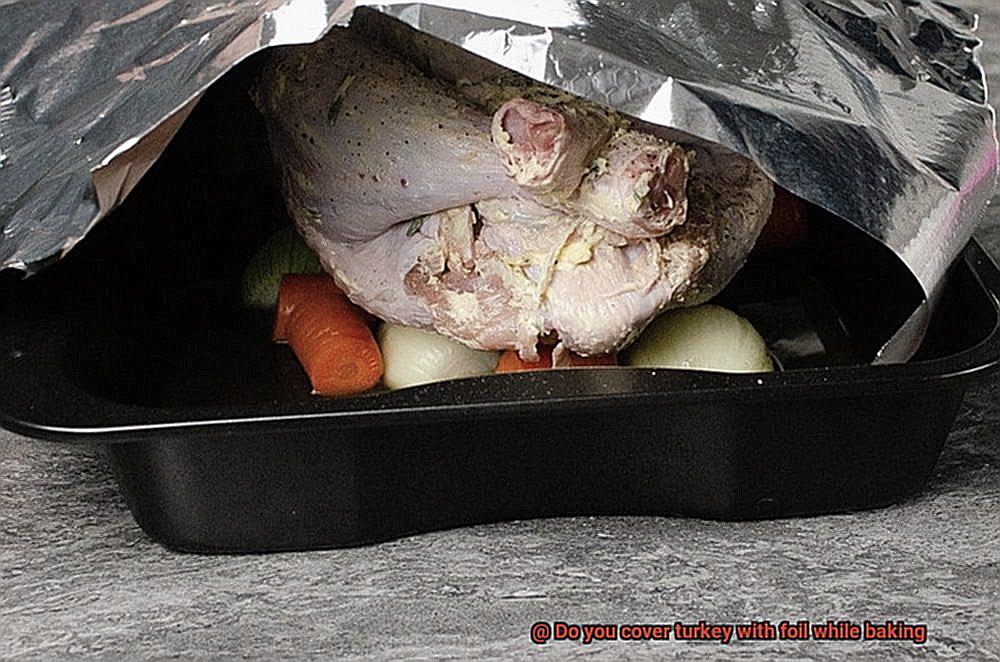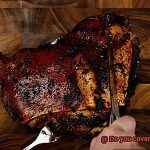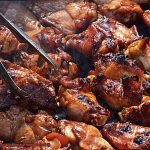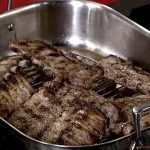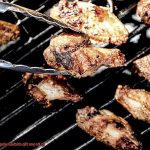Are you craving a succulent, smoky brisket that melts in your mouth with every bite? Maybe you’re new to the world of smoking meat and eager to impress your loved ones with a perfectly cooked brisket. If so, you might be wondering: should you flip a brisket when smoking?
Smoking meat is both an art and science, and there are countless techniques and opinions on how to smoke the perfect brisket. One of the most debated topics among pitmasters is whether or not to flip the brisket during the smoking process.
Some argue that flipping helps ensure even cooking and prevents dryness. Others believe that flipping can disrupt the formation of bark and smoke ring, resulting in less flavor.
So which method should you follow? In this post, we’ll explore both sides of the argument and provide tips for achieving mouthwatering results. Whether you choose to flip or not, get ready to elevate your BBQ game and become an expert pitmaster.
Contents
What is a Brisket?
This mouth-watering cut of beef is a Southern cuisine staple, originating from the breast of the cow. It’s known for being tough with fibrous muscles that require slow cooking to break down the collagen and connective tissue to make it tender and juicy.
- The brisket has two distinct parts: the flat and the point. The flat is a leaner cut, while the point is fattier and more flavorful. When smoking a brisket, it’s important to consider these differences and how they will cook. The flat requires more attention as it can dry out quickly, while the point is juicier but takes longer to cook.
- Now, let’s dive into the age-old question: should you flip your brisket while smoking it? Some pitmasters swear by flipping the meat, while others argue that it’s unnecessary and can even be detrimental to the final product.
On one hand, flipping a brisket can help ensure even cooking on both sides. This is especially important if your smoker has hot spots or uneven heat distribution. Additionally, flipping can prevent the bottom of the meat from becoming overly charred or burnt.
On the other hand, flipping can also be risky. Brisket is a tough cut of meat that needs low and slow cooking for several hours. Flipping it runs the risk of disturbing the bark (the flavorful crust that forms on the outside of the meat) and potentially losing some of the moisture inside.
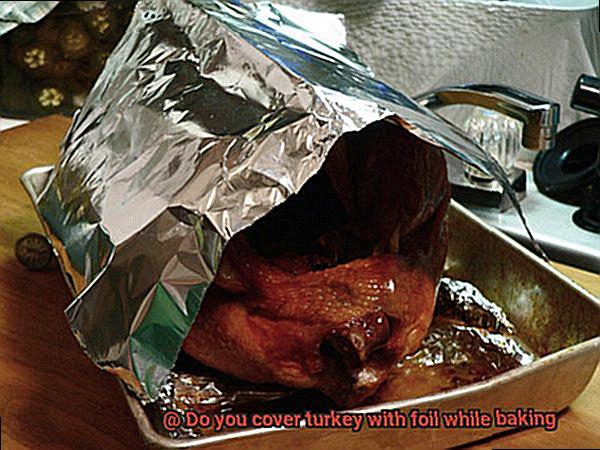
Ultimately, whether or not to flip your brisket while smoking is up to personal preference and experience. If you’re new to smoking brisket, it may be best to leave the meat undisturbed for most of the cooking process. However, if you have experience and feel comfortable flipping your brisket, go ahead and give it a try – just be sure to do so carefully and with caution.
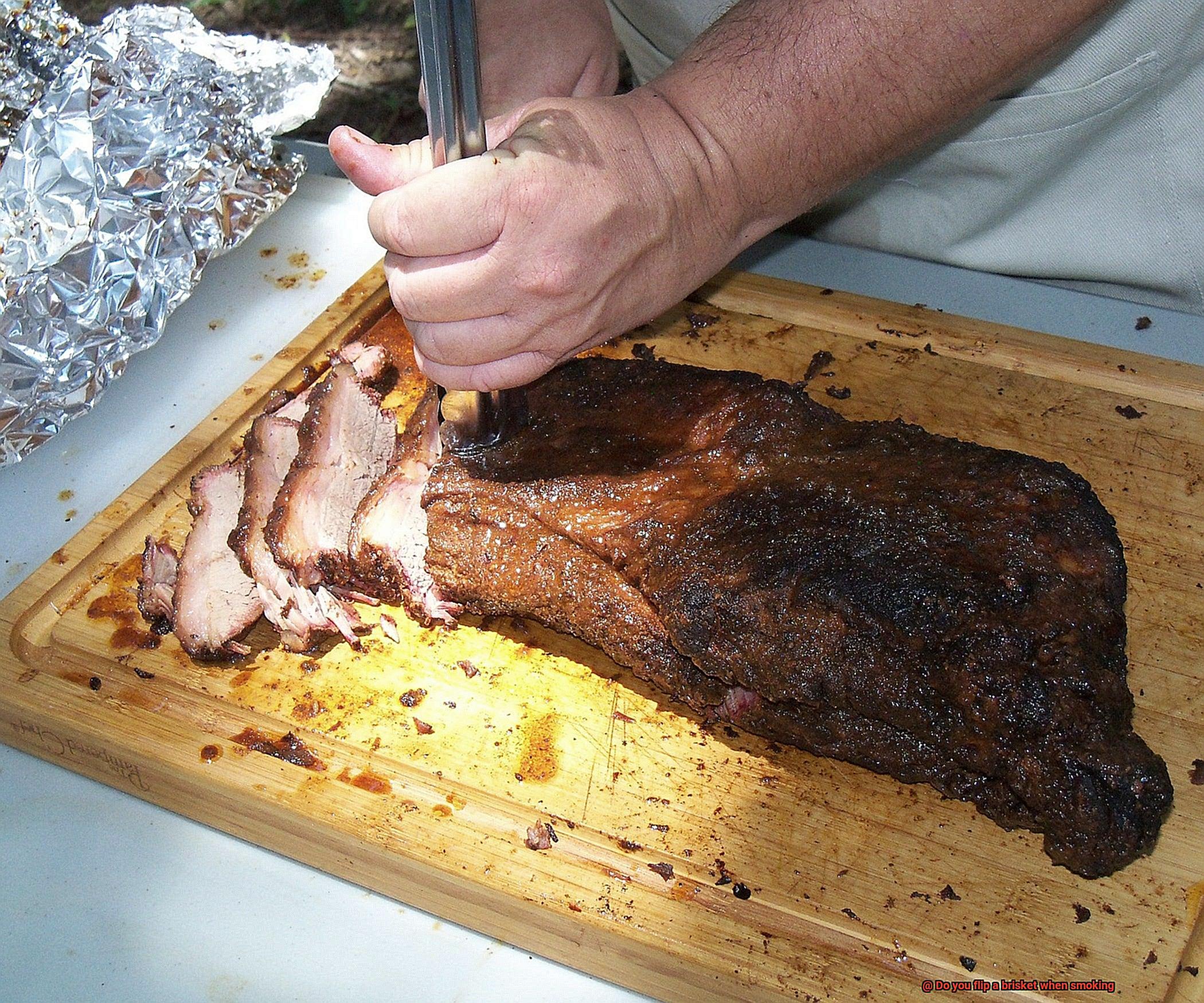
Smoking a brisket requires patience and attention to detail. It can take anywhere from 10-14 hours to fully smoke a brisket, depending on the size, thickness, and fat content. The key is to maintain a consistent temperature throughout the smoking process, which will ensure that your brisket comes out tender and juicy.
The Pros and Cons of Flipping a Brisket
In this section, we’ll explore the pros and cons of flipping a brisket when smoking, so you can make an informed decision for your next cookout.
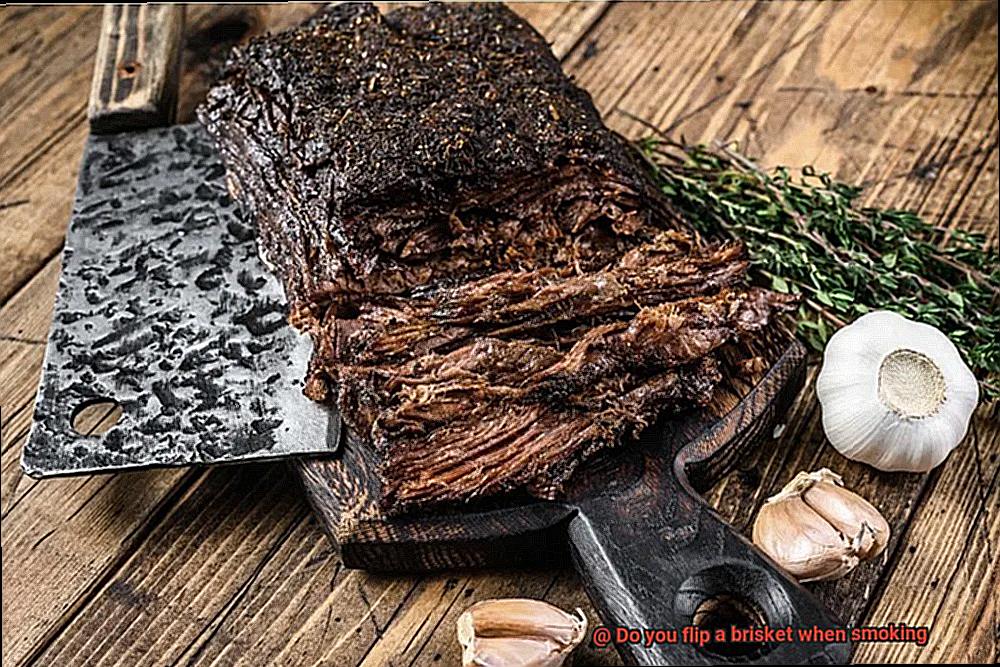
Let’s start with the pros. Flipping the brisket helps ensure even cooking on both sides, especially if you have a thicker cut of meat. This can be crucial in achieving a perfect cook, as heat takes longer to penetrate through thicker cuts. Additionally, flipping can help create an even bark formation on both sides of the meat, which is often considered the holy grail of smoked brisket. Lastly, flipping can prevent the meat from sticking to the grill grates or smoker racks, resulting in a more aesthetically pleasing final product.
However, flipping isn’t without its downsides. One major con is that it can cause the brisket to lose moisture each time it’s flipped. This can result in a less juicy and tender final product, which is never ideal. Additionally, flipping increases the risk of overcooking as each time you open up the smoker or grill, you’re letting out heat and smoke. This makes it harder to maintain a consistent cooking temperature and can lead to an overcooked or dry brisket. Lastly, flipping can disturb the bark formation, which can affect the overall flavor and texture of the final product.
So, what’s our verdict? Ultimately, it comes down to personal preference and experience. If you’re comfortable with flipping your brisket carefully and correctly, it can help create an even cook and bark formation. However, if you’re looking for a juicier and more tender final product with perfect bark formation, it’s best to leave your brisket untouched and allow it to form naturally.
Tips for Flipping a Brisket
When it comes to smoking a brisket, flipping it can be a game-changer. However, it’s important to approach it with caution and consideration for the cooking process. Here are five tips for flipping a brisket like a pro:
Use the Right Tools
When it comes to flipping your brisket, the right tools can make all the difference. A good pair of long-handled tongs or a sturdy spatula will allow you to handle the meat without risking burns or dropping it on the ground. Avoid using a fork, as piercing the meat can cause juices to escape and lead to dryness.
Don’t Flip Too Often
It can be tempting to check on your brisket frequently, but flipping it too often can interrupt the cooking process and prevent the meat from developing a consistent texture. As a general rule, it’s best to flip your brisket once per hour.
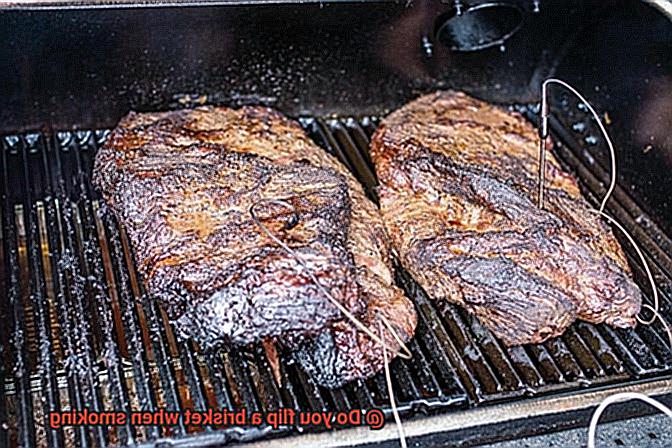
Consider Temperature
Timing is everything when it comes to flipping a brisket. Some pitmasters recommend waiting until the brisket has reached an internal temperature of around 160-170°F before flipping. This allows for the bark to form and prevents sticking to the grill grates. Be mindful of any additional seasonings or sauces you plan on applying to your brisket after flipping, and be sure to do so quickly and efficiently to prevent any major disruptions to the cooking process.
Mind Your Seasonings
The flavor of your brisket is just as important as its texture. When flipping your brisket, be mindful of any rubs or seasonings you’ve applied. You don’t want any of these flavorful elements to stick to the grill or smoker when flipping. A gentle touch and a steady hand are key when flipping a brisket.
Be Aware of Your Smoker’s Temperature
If your smoker isn’t heating evenly, you may need to adjust the position of your brisket or flip it more frequently to ensure even cooking on all sides. Keep an eye on your smoker’s temperature and adjust as needed to ensure your brisket is cooked to perfection.
Potential Benefits of Flipping a Brisket
As a die-hard brisket smoker, you’re always looking for ways to improve your cooking game. If you haven’t tried flipping your brisket during the smoking process, you might be missing out on some potential benefits that can result in a more delicious and tender end product.
Firstly, flipping your brisket ensures even cooking on both sides of the meat. When smoking a larger brisket, the heat from your smoker might not be evenly distributed. By flipping the meat periodically, you can prevent one side from becoming overcooked or undercooked, resulting in perfectly cooked meat.
But that’s not all. Flipping your brisket can actually help with bark formation, which is the crust formed on the outside of the meat during smoking. Flipping allows both sides of the brisket to develop a bark resulting in a more flavorful and textured end product. It’s like getting twice the flavor and texture in one delicious bite.
Another advantage of flipping your brisket is that it can prevent moisture loss. As the meat cooks, juices are released and can collect on one side of the brisket if it’s not flipped. This can result in uneven moisture distribution, leading to dry spots on some parts of the meat. By flipping the brisket, you can distribute the juices evenly and maintain a juicy and tender end product.
Of course, flipping your brisket requires a bit more effort and attention during the smoking process. Here are some tips to make sure you get it right:
- Use the right tools for flipping and handling your brisket.
- Flip once per hour to ensure even cooking.
- Mind the temperature to prevent overcooking or undercooking.
- Consider seasonings to enhance the flavor of your bark.
- Be aware of your smoker’s temperature and adjust as needed.
Potential Risks of Flipping a Brisket
While flipping a brisket may seem like a good idea, there are potential risks that could compromise the quality of your end result.
Firstly, flipping a brisket can lead to losing valuable moisture and flavor. The juices that accumulate on top of the brisket during the cooking process will be lost when it is flipped, resulting in a dry and less flavorful end product. No one wants to spend hours smoking a beautiful piece of meat only to have it turn out dry and tasteless.
Secondly, frequent flipping can cause the brisket to become unevenly cooked or break apart. Briskets are large cuts of meat that require a long cooking time to become tender. Flipping the brisket too early or frequently can cause it to break apart or cook unevenly, resulting in tough and chewy meat. This is certainly not what we want after dedicating so much time and effort into smoking a delicious brisket.
In addition to these risks, frequent flipping can also increase the likelihood of flare-ups and temperature fluctuations in the smoker. When the smoker is opened to flip the brisket, oxygen flows in and can cause flare-ups that might burn the meat or cause uneven cooking. Temperature fluctuations can also prolong cooking time and negatively impact the overall quality of the brisket.
To ensure a tender and flavorful brisket, it’s best to limit flipping and allow it to cook on one side for an extended period before carefully flipping it once or twice towards the end of the cooking process. This approach will help retain moisture and flavor, prevent uneven cooking and breakage, and reduce the risk of flare-ups and temperature fluctuations.
How to Avoid Common Mistakes When Flipping a Brisket
Smoking a brisket can be a daunting task, but it can also be a rewarding experience. One of the most controversial topics among pitmasters is whether or not to flip the brisket during cooking. While some swear by flipping, others believe it’s unnecessary. However, if you do decide to flip your brisket, there are some common mistakes to avoid to ensure a delicious and tender final product.
Timing is Everything
Timing is crucial when it comes to flipping a brisket. Flipping too early can cause the meat to tear and lose its juices, while flipping too late can result in overcooked and burnt meat. To determine the right time to flip your brisket, use a meat thermometer to monitor the internal temperature. When the temperature reaches around 160-170°F, it’s usually safe to flip the brisket. However, every brisket is different, so use your judgement and experience to determine when to flip.
Gentle Handling
Brisket is a delicate cut of meat that requires gentle handling. Roughly handling it can cause it to fall apart, losing those flavorful juices inside the meat. Use two spatulas or forks to carefully lift and flip the brisket, making sure not to pierce or tear the meat.
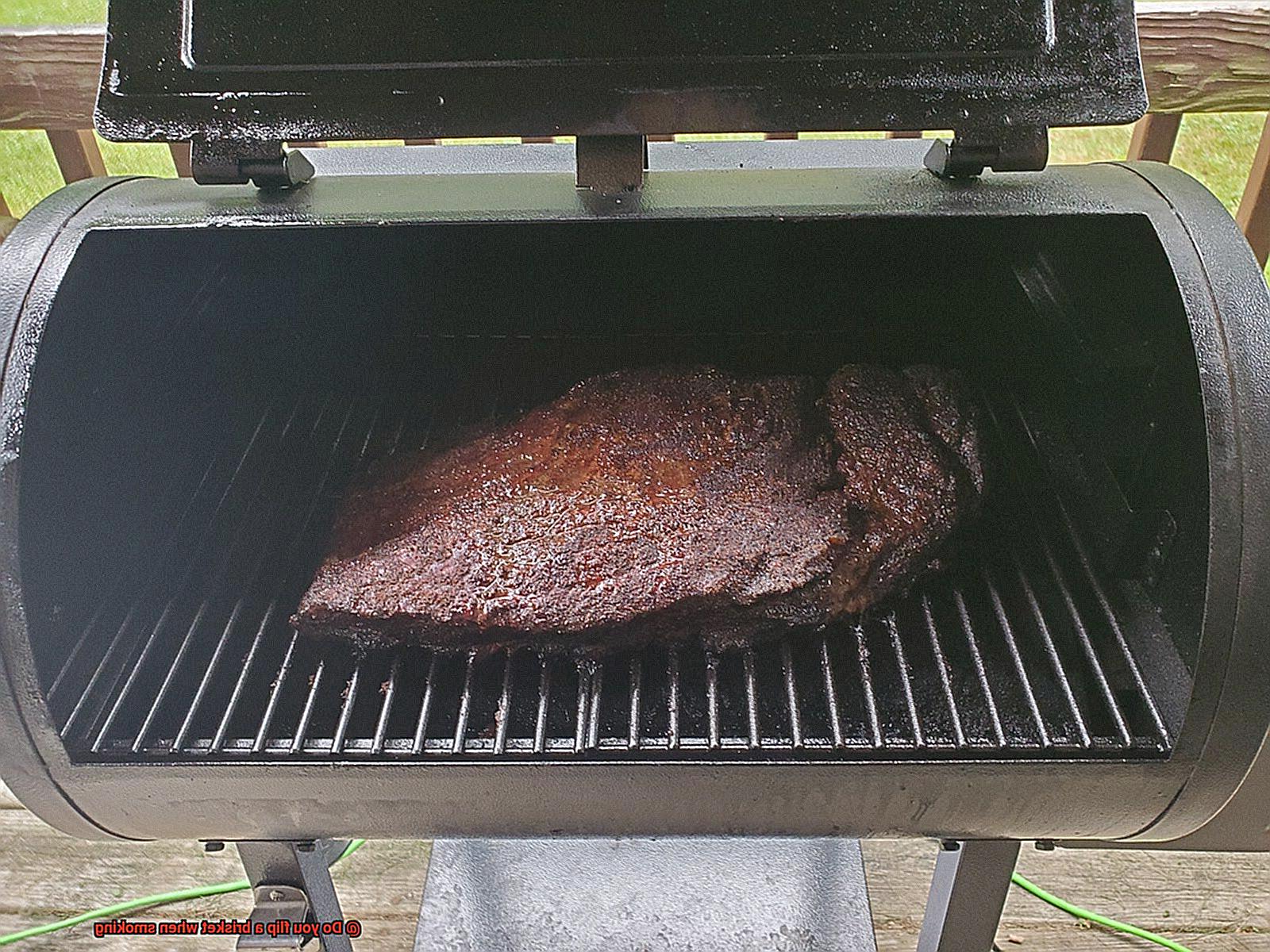
Don’t Flip Too Many Times
Flipping your brisket too many times can increase the risk of drying out the meat or causing it to become overcooked. Flipping it once or twice during the cooking process is usually enough to ensure even cooking on both sides. Resist the temptation of constantly flipping your brisket and let it cook undisturbed.
Use Proper Tools
Using proper tools when flipping a brisket is essential for safety and handling. A good pair of heat-resistant gloves and long tongs will protect your hands while safely handling the hot meat.
Monitor the Internal Temperature
Flipping can affect the cooking time and temperature, so it’s important to monitor the internal temperature regularly with a meat thermometer. If you notice that your brisket is cooking faster or slower than expected, adjust your cooking time accordingly.
Alternatives to Flipping a Brisket
As a true connoisseur of brisket, I understand the importance of achieving that perfect balance of flavor and tenderness. Flipping the brisket during smoking is a common technique, but it can cause the meat to lose moisture and taste. Luckily, there are alternative methods to achieve even cooking without compromising the quality of your brisket.
One alternative method is to rotate the brisket. Rather than flipping it over, simply turn it 180 degrees every hour or so. This technique ensures that both sides cook evenly without sacrificing any of the flavor or moisture of your brisket.
Another effective method is to use a convection plate. This plate sits above the firebox and distributes heat evenly throughout the smoker, eliminating the need for flipping or rotating your brisket. With this technique, your brisket will cook evenly while maintaining its signature flavor and tenderness.
Finally, some pitmasters swear by the Texas Crutch technique. This involves wrapping your brisket in foil or butcher paper halfway through the cooking process to retain moisture and achieve a more tender end result.
Conclusion
To sum it up, smoking a brisket is an intricate process that requires precision, dedication, and experimentation. The age-old question of whether or not to flip the meat during smoking has been debated by pitmasters for years. While some swear by flipping to ensure even cooking and prevent dryness, others argue that it interferes with the bark formation and smoke ring, resulting in less flavor.
Ultimately, the decision to flip or not depends on your personal preference and experience. If you’re new to smoking brisket, it’s best to leave it be for most of the process. However, if you’re confident in your skills, go ahead and give it a try – but do so with caution.
If you opt to flip your brisket, there are some tips to keep in mind. Use proper tools for handling the meat and avoid flipping too often. Consider temperature and seasonings while being mindful of your smoker’s temperature. Alternatively, rotating the brisket or using a convection plate can also yield delicious results.
Smoking a perfect brisket takes time and practice. Whether you choose to flip or not, remember that patience is key – it can take anywhere from 10-14 hours to fully smoke a brisket.

